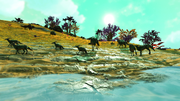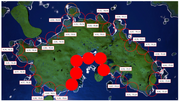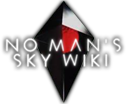| The subject of this article is from the Visions update.
The information from this article is up-to-date as of 13 August, 2019. |
The information from this article is up-to-date as of 13 August, 2019.
| This article was catalogued by the Galactic Hub. |
| Olverha | |
|---|---|

| |
| Galaxy | Euclid |
| Region | The Arm of Katteus |
| Star system | HUB4-130 Paradise Beaks |
| Atmosphere | Pleasant; Mildly Hazy |
| Terrain | Oceans, Islands, Lake-covered Landmasses |
| Biome | Lush |
| Weather | Blissful |
| Resources | C C+ Cl Co Cu Ke Na NaCl Mo O2 Pf Sb |
| Sentinels | Average |
| Flora | Abundant |
| Fauna | Ample |
| Discovered by | jawertown; first documented by old_school_rpg |
| Discovery platform | PS4 |
| Game Mode | Normal |
| Updated | Visions |
Olverha is a planet in No Man's Sky.
Summary[ | ]

A small herd, or large family, of T. Soilpitamum (Decibel Deer) near the shoreline.
Olverha is a planet in the HUB4-130 Paradise Beaks system. This tropical planet has many notable features, including: a species of megafauna (~6m) Mogara / Grunts, a species of rare violet flower-trees rarely seen elsewhere in-game, beautiful beaches and underwater caves, yellow bubble / lollipop grass, a Cycromys / bird species, and more.
It's also the location of the Galactic Hub's fourth colony, the coastal colony of Dorinish. See Notable Locations & Waypoints for more info.
Alias names[ | ]
| PS4 | Current: | Olverha |
|---|
| PC | Current: | Lamuella |
|---|
| XBox | Current: | Red Grass No Rain Space Hawaii |
|---|
Resources[ | ]
- “Form” refers to, for example: crystal form, resource deposit form, Pedestal Form (Vortex Cube), “Stem Plant” Form (Gravitino Ball), “Floating Crystal” Form (Rare Metal Element/others), etc
- “Rarity” refers to how often the resource appears on the planet, and is just an estimate (there’s no in-game value to measure it by).
- Standard resources like Carbon, Condensed Carbon, Sodium, etc. may be included or omitted at the editor’s discretion.
| Image | Resource | Form | Rarity |
|---|---|---|---|
| Carbon | Plants | Abundant | |
| Chlorine | Underwater Rocks | Uncommon | |
| Condensed Carbon | Crystals | Common | |
| Copper | Resource Deposit | Somewhat Rare | |
| Coprite | Fauna-sourced | Abundant (if fauna are fed) | |
| Crystal Sulphide | Underwater Vents | Common | |
| Di-hydrogen | Crystals | Common | |
| Kelp Sac | Aquatic Plants | Somewhat Common | |
| Mordite | Fauna-sourced | Abundant (if fauna are killed) | |
| Salt | Underwater Rocks | Common | |
| Sodium | Flowers | Somewhat Common |
Life[ | ]
Fauna[ | ]
| Name | Behavior & Diet | Height | Weight | ||
|---|---|---|---|---|---|

|
Best Friend | Cheerful Mordite roots |
5.9m | 289.4kg | |
| dangerdorian | Genus: Mogara | Notes: -EXTINCT- Large Grunt species, mostly brown with white underbelly & face. Teddy-bear-like and bird-like gender appearances. | |||

|
T. Soilpitamum | Slow grazer Grass |
1.5m | 74.7kg | |
| hemlock09 | Genus: Tetraceris | Notes: -EXTINCT- Green, long-nosed antelope species with feather-like manes/frills around their necks. Red backs dotted with blue-red pustules, perhaps a part of the animal but seemingly a parasite, symbiote, or otherwise foreign organism. Generally found in large herds, and generally very loud, earning them the local nickname "decibel deer". | |||

|
M. Copmidia | Long-distance migration Mostly rocks |
3.2m | 145.8kg | |
| Forrest904 | Genus: Ungulatis | Notes: -EXTINCT- Green/brown or red (depending on gender), fairly large horned bovine. Thick forelegs, thin back legs, and what appears to be some sort of foreign organism on its back. Generally found in herds, in small groups, or alone. This species appears to be equally active regardless of time of day. | |||

|
R. Falconsonium | Highly observant Vegetation |
0.6m | 78.3kg | |
| hemlock09 | Genus: Procavya | Notes: -EXTINCT- Green/brown rodent with vivid red bumps on its back. Sharp teeth and bright yellow eyes. This species is barely taller than the grass on this planet. | |||

|
E. Mustloctoe | Lone predator Cannibalism |
2.1m | 139.3kg | |
| AndyKrycek6 | Genus: Prionace | Notes: -EXTINCT- Bright green shark with ornate white patterns down the majority of its body. Green teeth. Brown protrusions in the forehead area: could just be some scales, or could be a sensory organ. Generally found alone but other individuals may be found in the vicinity. Seems to prefer deeper water. Excellent sense of smell | |||

|
D. Radionoposa | Drifts on currents Small crustaceans |
0.9m | 61.9kg | |
| old_school_rpg | Genus: Ictaloris | Notes: -EXTINCT- Green jellyfish with black eyes extending from long stalks. May be found in pairs or larger groups. | |||

|
U. Pentaniia | Effectively blind Living sponges |
0.7m | 72.7kg | |
| old_school_rpg | Genus: Ictaloris | Notes: -EXTINCT- Medium-sized blue/white fish with black stripes and a long mouth full of sharp teeth. This species is always found in schools. | |||

|
A. Funnuncia | Never sleeps Seaweed |
0.5m | 42.5kg | |
| old_school_rpg | Genus: Ictaloris | Notes: -EXTINCT- Small, fairly round/spherical, brown fish with black stripes and some pale green features, such as the dorsal and tail fins. Always found in schools. Extremely homozygous | |||

|
M. Tribbritsia | Passive Living sponges |
1.5m | 83.8kg | |
| hemlock09 | Genus: Conokinis (?) | Notes: -EXTINCT- Eight-legged brownish crabs with two large claws. May feature white stripes on the head/dorsal area depending on gender. Generally found alone, but other individuals are often in the vicinity. Seems to prefer shallow water. | |||

|
S. Chromoradeum | Easily scared Gravitino balls |
1.4m | 79.6kg | |
| hemlock09 | Genus: Cycromys | Notes: -EXTINCT- Individuals belonging to this species of large, "dragon-like" birds (Cycromys) can usually be found traveling in pairs. Common behavior is to appear, swoop down towards the ground or circle for a while, then fly into the distance. This species skin varies from dark to very pale green in color. Each wing is segmented into six sections and does not appear to feature feathers but rather stretched skin or other membrane. Each wing features two talons, and the species also displays a long tail which widens into a flat club-like shape near the end. | |||

|
I. Polycicae | Collects shiny objects Rotting fruit |
0.9m | 50.8kg | |
| Krentebol01 | Genus: Agnelis | Notes: -EXTINCT- These four-winged fauna have a face which resembles a cross between a bat and a pug. Their front wings are mostly white, while the posterior wings are mostly blue. They also display two long tails. As the wings don't appear to have any feathers, this species may be more comparable to a bat than a bird in Earth biology. | |||
Zoology Scan Completion[ | ]
PS4: 11/13
PC:
XBox:
Flora[ | ]
Atmosphere & Climate[ | ]
- Maximum Temperature: 104.3 °F / 40.2 °C
- Minimum Temperature:
- Storm Temperature:
- Radioactivity (Rad): 1.9
- Toxicity (Tox): 19.3
Notable Locations & Waypoints[ | ]
| Image | Name | Description | Latitude/Longitude |
|---|---|---|---|
 |
Dorinish Colony | See Below | -5.00, 79.00 |
Dorinish Colony[ | ]

A map of Dorinish
Dorinish is the Galactic Hub's fourth official colony - an organized settlement of multiple player bases. Inspired by Southern California, Dorinish residents live along the coastlines and are encouraged to build small-to-medium-sized homes which occupy both the land and sea.
Base sites are spaced approximately 400u apart (each base claim has a 200u radius). Base sites can be claimed on the Residency Spreadsheet. Be sure to do this before placing a base computer
Settling on Dorinish[ | ]
- Navigate to the system
- Find the planet
- Explore the available planetary coordinates (listed on spreadsheet above, or map in thumbnail image)
- Find one you like and make sure it's not already claimed on the spreadsheet
- If it's already claimed, find another spot; if not, claim it for yourself
That's it! 30 spots per platform are available on a first-come first-serve basis and if no base is built after some number of weeks, the base claim may be forfeited, following notification by Galactic Hub Staff.
Rules and Guidelines[ | ]
- Do not claim a base site which has already been claimed (steal a claim). The spreadsheet has a version history: Hub staff will see, and it's not a good way to be seen.
- Try to keep your base somewhat small to minimize lag.
- Small exterior features which aren't a part of your base, like fountains, parks, small public gardens, statues, etc are strongly encouraged. This will make the colony feel more connected and settled in the absence of roads.
- If you expect to play No Man's Sky in VR, build your base with that in mind!













